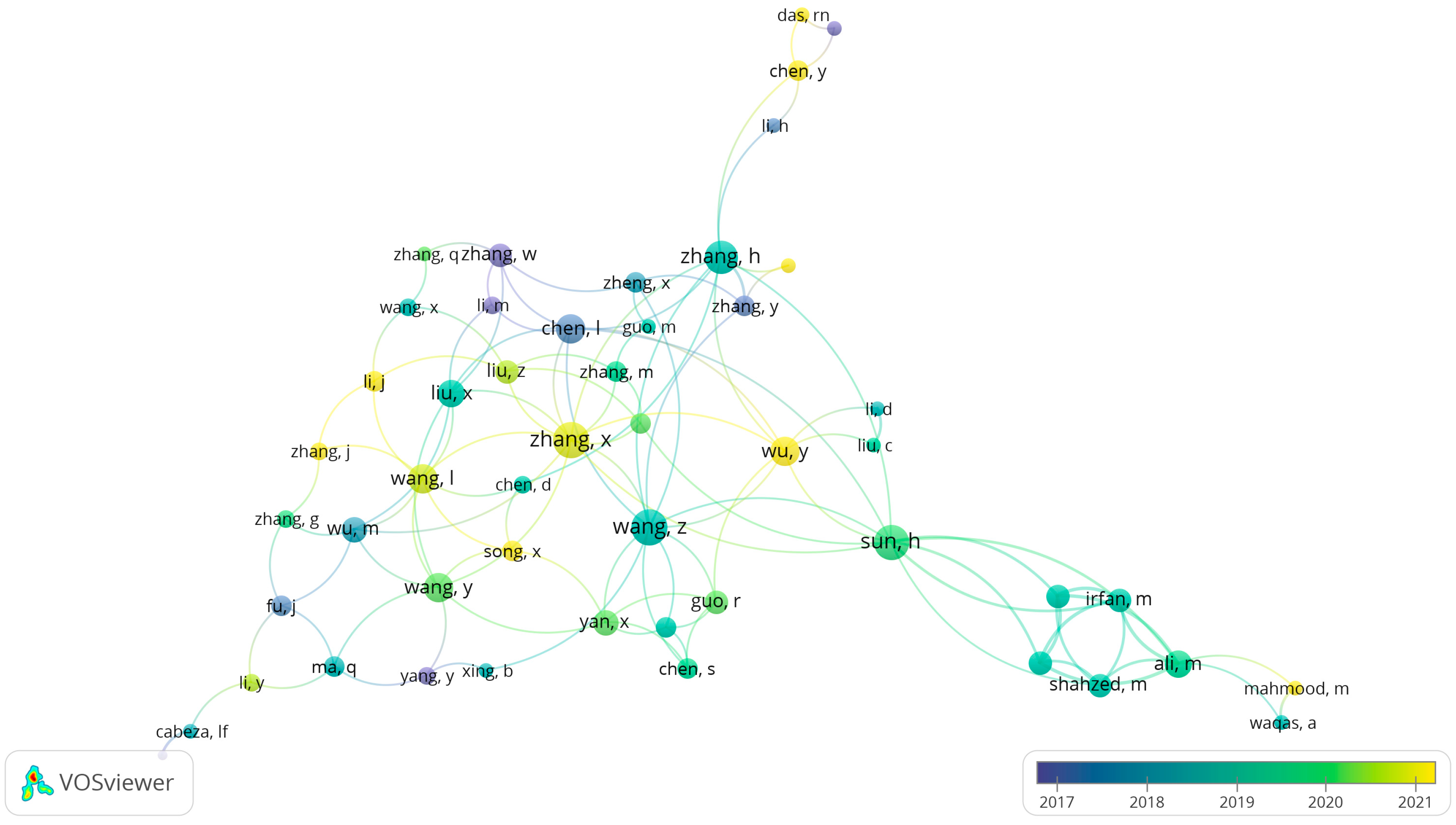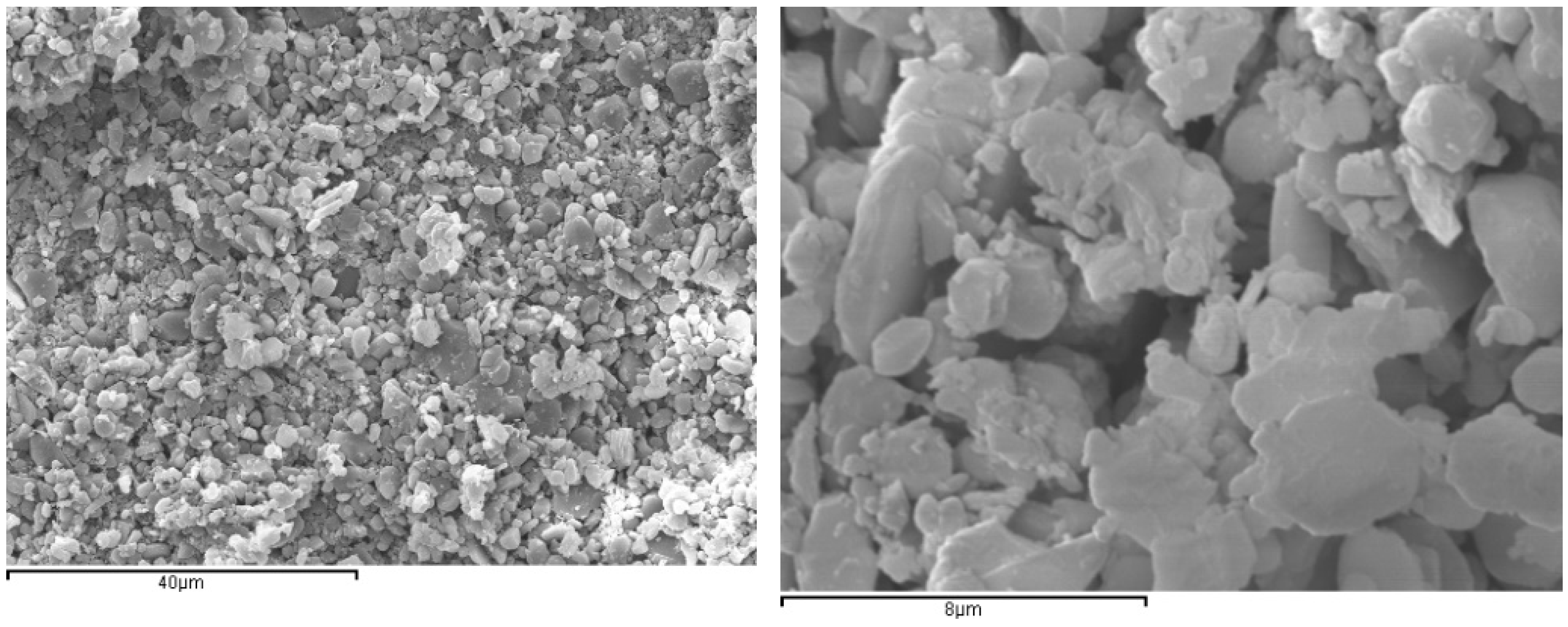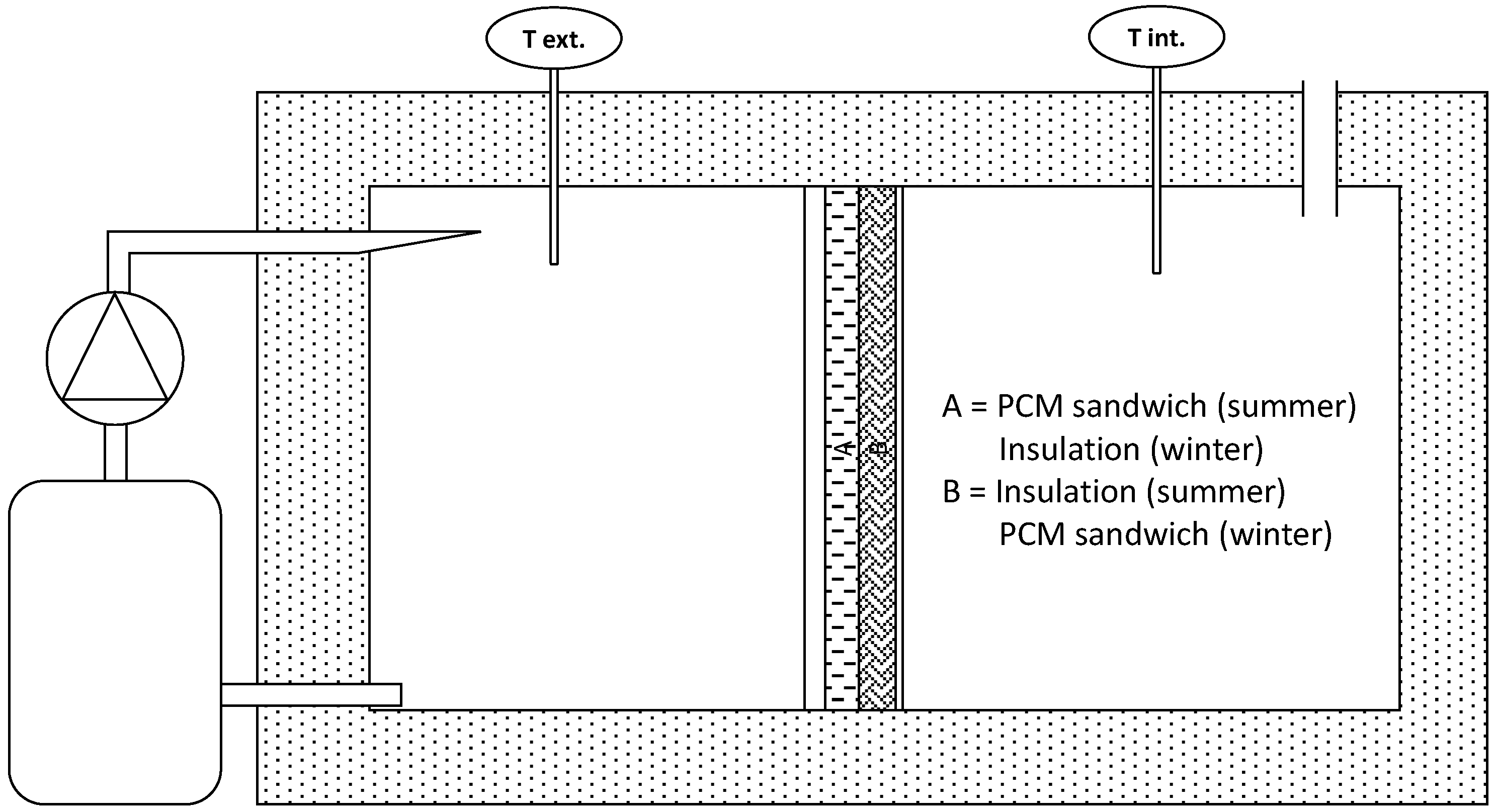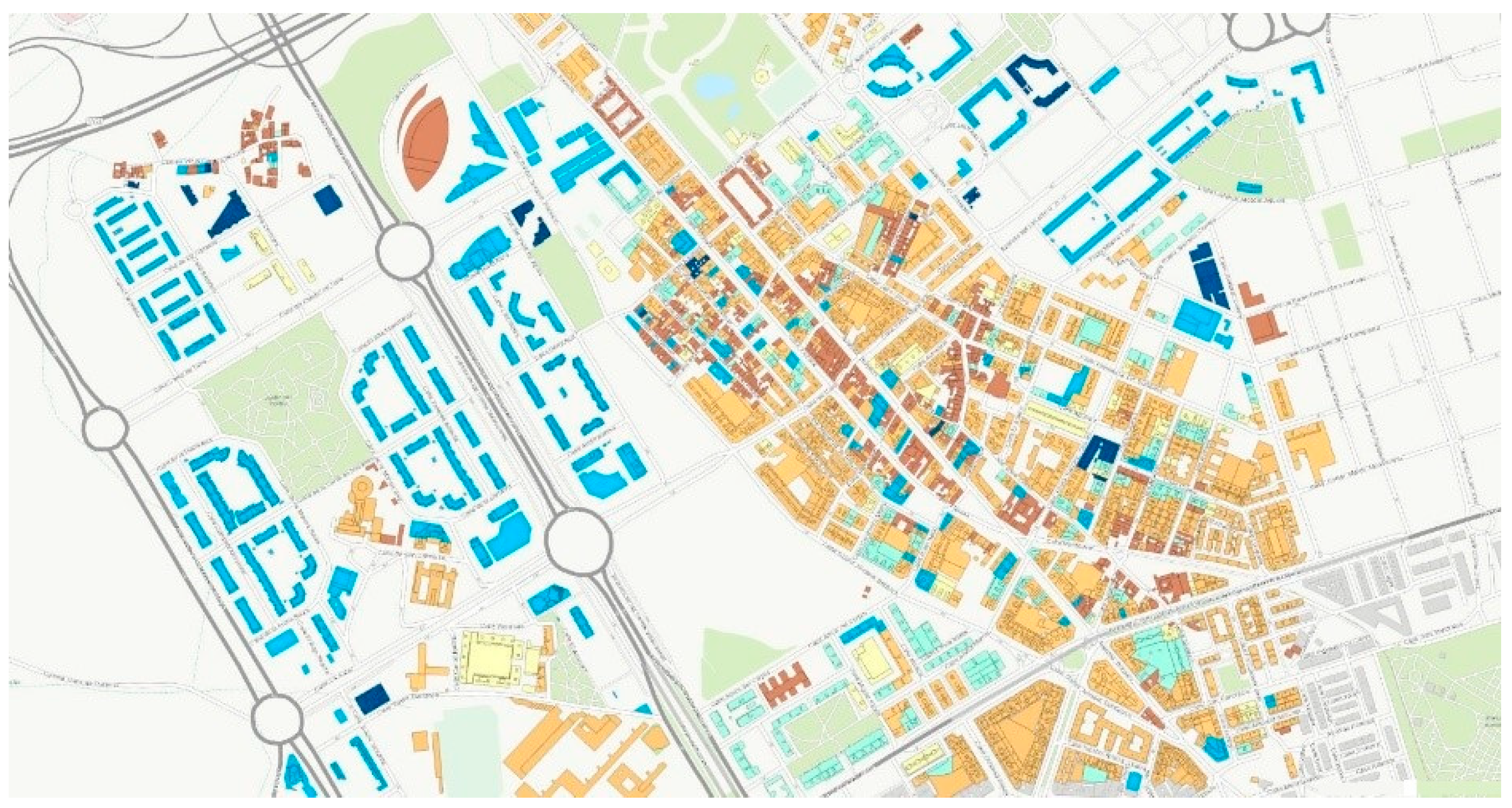City Regeneration through Modular Phase Change Materials (PCM) Envelopes for Climate Neutral Buildings
Abstract
:1. Introduction
2. Background Literature Review
- Long term energy performance under different climate conditions has been well studied by Pajek et al. [13], including climate change scenarios; they concluded that a combination of tailored envelope designs with passive ventilation renders the best energy performance.
- Urban retrofitting policies have been reported as an emergent opportunity for fighting climate change [14] in most climate scenarios.
- Under dominant climate conditions, including climate change scenarios, the most efficient building refurbishment solutions relate to envelope interventions focused on materials capable of reducing the building’s peak energy loads [15].
- In PCM module design, modularity is required for implementing circularity of the regeneration components (material carbon footprint reduction) as well as minimum installation and operation costs (easy maintenance). The building renovation wave should consider adequate criteria on materials reuse and incorporation into standardized modular elements, fitting with the regeneration market [16,17]. The main conclusion is that sandwich layers (insulation and/or PCM) held in place by standard size hard surfaces can meet user requirements.
- For selection of relevant commercially available PCM, several points are relevant and have been addressed by al-Yashiri et al. [18] in their analysis:
- ○
- PCMs should be selected from cheap sustainable alternatives with high solidification enthalpy and cycle stability;
- ○
- They require a conductive rigid support for best performance;
- ○
- The PCM layer should be closest to the warm face of the application;
- ○
- The melting temperature should be close to the comfort requirements.
- Following an extensive review and performance analysis of the main building envelope design solutions in different climate conditions, Arumugam et al. [19] concluded that:
- ○
- Natural cross-ventilation both in internal and external faces is critical;
- ○
- Humidity control through green infrastructure is desirable;
- ○
- Insulation integration performs well in the most critical condition;
- ○
- Leakage is critical and should be considered together with maintenance requirements and fire risk.
- External NBS influence: As demonstrated through the wide analysis of connected green infrastructure deployment at street level by Marando et al. [20], a street cover of 16% enhances the external temperature conditions by 1–2 °C while controlling wind, radiation, and humidity impacts.
- Internal heat load control (passive systems): Controlling internal heat loads is critical for assessing the relevant impact of PCM-based strategies. According to Coma et al. [21], thermal loads should be distributed and balanced through ventilation and vegetation-based humidity control. According to Moussavi et al. [22], a reduction of 1–3 °C in internal temperature can be expected.
- A comprehensive approach to impact assessment evaluation of the proposed combined strategy for passive climate mitigation through PCMs relies on a full Life Cycle Assessment (LCA) at the neighbourhood level through the simulation of expected physical and weather conditions [23].
3. Materials and Methods
3.1. PCM Modules
3.2. Neighbourhood Model
- Street temperatures were taken from the Valencia Open Data portal [31], which corresponds to the climate station in Benicalap. Because the meteorological station for Benicalap is not within a green area, those streets with a green area over 16% area coverage are considered to have a temperature 2 °C lower.
- When a building is refurbished, PureTemp23 PCM panels will be installed and internal air flow ducts installed from the warm to the cold face, reducing the comfort temperature requirements by 2 °C.
3.3. Methods and Proposed Research
4. Results
5. Discussion
6. Conclusions
Author Contributions
Funding
Institutional Review Board Statement
Informed Consent Statement
Data Availability Statement
Conflicts of Interest
References
- Sustainable Development Goal 11: Make Cities Inclusive, Safe, Resilient and Sustainable. Available online: https://sdg-tracker.org/cities (accessed on 18 June 2022).
- Peng, Y.; Lai, Y.; Li, X.; Zhang, X. An alternative model for measuring the sustainability of urban regeneration: The way forward. J. Clean. Prod. 2015, 109, 76–83. [Google Scholar] [CrossRef]
- Renovating the EU Building Stock Will Improve Energy Efficiency While Driving the Clean Energy Transition. Available online: https://energy.ec.europa.eu/topics/energy-efficiency/energy-efficient-buildings/renovation-wave_en (accessed on 18 June 2022).
- UN Habitat Expert Group. Urban Regeneration as a Tool for Inclusive and Sustainable Recovery. 2022. Available online: https://unhabitat.org/sites/default/files/2022/05/report_egm_urban_regeneration.pdf (accessed on 18 June 2022).
- Khan, H.S.; Paolini, R.; Caccetta, P.; Santamouris, M. On the combined impact of local, regional, and global climatic changes on the urban energy performance and indoor thermal comfort-The energy potential of adaptation measures. Energy Build. 2022, 267, 112152. [Google Scholar] [CrossRef]
- Nicol, F.; Rijal, H.B.; Roaf, S. (Eds.) Handbook of Resilient Thermal Comfort; Chapter 15; Routledge: London, UK, 2022; ISBN 9781032155975. [Google Scholar]
- Rajput, T.S.; Thomas, A. Optimizing passive design strategies for energy efficient buildings using hybrid artificial neural network (ANN) and multi-objective evolutionary algorithm through a case study approach. Int. J. Constr. Manag. 2022, 8, 1–13. [Google Scholar] [CrossRef]
- Dimensions. Available online: https://app.dimensions.ai/discover/publication (accessed on 18 June 2022).
- Sharma, A.; Chauhan, R.; Kallioğlu, M.A.; Chinnasamy, V.; Singh, T. A review of phase change materials (PCMs) for thermal storage in solar air heating systems. Mater. Today Proc. 2021, 44 Pt 6, 4357–4363. [Google Scholar] [CrossRef]
- Zhu, S.; Nguyen, M.T.; Yonezawa, T. Micro- and nano-encapsulated metal and alloy-based phase-change materials for thermal energy storage. Nanoscale Adv. 2021, 3, 4626–4645. [Google Scholar] [CrossRef]
- Gholamibozanjani, G.; Farid, M. A Critical Review on the Control Strategies Applied to PCM-Enhanced Buildings. Energies 2021, 14, 1929. [Google Scholar] [CrossRef]
- Zavrl, E.; el Mankibi, M.; Dovjak, M.; Stritih, U. Enhancing performance of building elements with phase change materials for cooling with air-based systems. J. Energy Storage 2022, 51, 104461. [Google Scholar] [CrossRef]
- Pajek, L.; Kosir, M. Strategy for achieving long-term energy efficiency of European single-family buildings through passive climate adaptation. Appl. Energy 2021, 297, 117116. [Google Scholar] [CrossRef]
- Egerer, M.; Haase, D.; McPhearson, T. Urban change as an untapped opportunity for climate adaptation. NPJ Urban Sustain. 2021, 1, 22. [Google Scholar] [CrossRef]
- de Masi, R.F.; Gigante, A.; Ruggiero, S.; Vanoli, G.P. Impact of weather data and climate change projections in the refurbishment design of residential buildings in cooling dominated climate. Appl. Energy 2021, 303, 117584. [Google Scholar] [CrossRef]
- Neri, M.; Pilotelli, M.; Traversi, M.; Levi, E.; Piana, E.A.; Bannó, M.; Cuerva, E.; Pujadas, P.; Guardo, A. Conversion of End-of-Life Household Materials into Building Insulating Low-Cost Solutions for the Development of Vulnerable Contexts: Review and Outlook towards a Circular and Sustainable Economy. Sustainability 2021, 13, 4397. [Google Scholar] [CrossRef]
- Hartkopf, V.; Aziz, A.; Loftness, V. Facades and Enclosures: Building for Sustainability. In Sustainable Built Environments; Loftness, V., Ed.; Encyclopedia of Sustainability Science and Technology Series; Springer: New York, NY, USA, 2020; pp. 295–325. [Google Scholar] [CrossRef]
- al-Yashiri, Q.; Szabo, M. Incorporation of phase change materials into building envelope for thermal comfort and energy saving: A comprehensive analysis. J. Build. Eng. 2021, 36, 102122. [Google Scholar] [CrossRef]
- Arumugam, P.; Ramalingam, V.; Vellaichamy, P. Effective PCM, insulation, natural and/or night ventilation techniques to enhance the thermal performance of buildings located in various climates—A review. Energy Build. 2022, 258, 111840. [Google Scholar] [CrossRef]
- Marando, F.; Heris, M.P.; Zulian, G.; Udías, A.; Mentaschi, L.; Chrysoulakis, N.; Parastatidis, D.; Maes, J. Urban heat island mitigation by green infrastructure in European Functional Urban Areas. Sustain. Cities Soc. 2022, 77, 103564. [Google Scholar] [CrossRef]
- Coma, J.; Chafer, M.; Perez, G.; Cabeza, L.F. How internal heat loads of buildings affect the effectiveness of vertical greenery systems? An experimental study. Renew. Energy 2020, 151, 919–930. [Google Scholar] [CrossRef]
- Mousavi, S.; Gijon-Rivera, M.; Rivera-Solorio, C.I.; Godoy Rangel, C. Energy, comfort, and environmental assessment of passive techniques integrated into low-energy residential buildings in semi-arid climate. Energy Build. 2022, 263, 112053. [Google Scholar] [CrossRef]
- Orozco-Messana, J.; Iborra-Lucas, M.; Calabuig-Moreno, R. Neighbourhood Modelling for Urban Sustainability Assessment. Sustainability 2021, 13, 4654. [Google Scholar] [CrossRef]
- Calabuig-Moreno, R.; Temes-Cordovez, R.; Orozco-Messana, J. Neighbourhood Digital Modelling of Energy Consumption for Carbon Footprint Assessment. In Sustainability in Energy and Buildings 2021; Littlewood, J.R., Howlett, R.J., Jain, L.C., Eds.; Smart Innovation, Systems and Technologies; Springer: Singapore, 2022; Volume 263. [Google Scholar] [CrossRef]
- Present and Future Köppen-Geiger Climate Classification Maps at 1-Km Resolution. 2018. Available online: https://www.nature.com/articles/sdata2018214 (accessed on 6 July 2022).
- Esri. Available online: https://www.esri.com/en-us/arcgis/products/arcgis-pro/overview (accessed on 19 June 2022).
- Welcome to the Joint EPISCOPE and TABULA Website. Available online: https://episcope.eu/welcome/ (accessed on 19 June 2022).
- IVE Construction Materials Database. Available online: https://www.five.es/tienda-ive/base-de-datos-de-construccion-2021/ (accessed on 19 June 2022).
- City Energy Analyst. Available online: https://cityenergyanalyst.com/ (accessed on 19 June 2022).
- ArcGIS API for Python. Available online: https://pro.arcgis.com/es/pro-app/2.8/arcpy/get-started/arcgis-api-for-python.htm (accessed on 19 June 2022).
- Datasets. Available online: https://datos.gob.es/en/catalogo?publisher_display_name=Ayuntamiento+de+Valencia&theme_id=medio-ambiente (accessed on 19 June 2022).
- Braulio-Gonzalo, M.; Jorge-Ortiz, A.; Bovea, D. How are indicators in Green Building Rating Systems addressing sustainability dimensions and life cycle frameworks in residential buildings? Environ. Impact Assess. Rev. 2022, 95, 106793. [Google Scholar] [CrossRef]
- Cheng, B.; Lu, K.; Li, J.; Chen, H.; Luo, X.; Shafique, M. Comprehensive assessment of embodied environmental impacts of buildings using normalized environmental impact factors. J. Clean. Prod. 2022, 334, 130083. [Google Scholar] [CrossRef]
- Khan, L.U.; Saad, W.; Niyato, D.; Han, Z.; Hong, C.S. Digital-Twin-Enabled 6G: Vision, Architectural Trends, and Future Directions. IEEE Commun. Mag. 2022, 60, 74–80. [Google Scholar] [CrossRef]








| PCM Type | Reference | Manufacturer | T (°C) | Enthalpy (jul/gr) |
|---|---|---|---|---|
| Organic | RT21HC | Rubitherm | 21 | 150 |
| PureTemp23 | PureTemp | 23 | 203 | |
| Beeswax25 | BASF | 25 | 142 | |
| Inorganic | DS5040X | BASF | 24 | 168 |
| MPCM24D | Microtek | 25 | 197 |
| Reference | Maximum ΔT (°C, Summer) | Maximum ΔT (°C, Winter) | Energy Saving (%) |
|---|---|---|---|
| RT21HC | 11 | −12 | 10 |
| PureTemp23 | 2.6 | −2 | 25 |
| Beeswax25 | 3.6 | −10.9 | 12 |
| DS5040X | 3.7 | −9.7 | 19 |
| MPCM24D | 7.6 | −8.6 | 17 |
| Building Typology (Year Interval) | 2019 CO2 Footprint (tnCO2/Year) | 2019 Refurbished CO2 Footprint (tnCO2/Year) | Investment Return (Months) | Number of Buildings | ||
|---|---|---|---|---|---|---|
| Embedded | Usage | Embedded | Usage | |||
| <1900 | 0.09 | 1.82 | 0.17 | 1.36 | 41 | 34 |
| 1901–1936 | 0.42 | 4.72 | 1.54 | 4.28 | 36 | 139 |
| 1937–1959 | 0.63 | 6.37 | 2.85 | 5.21 | 38 | 184 |
| 1960–1979 | 1.20 | 9.85 | 5.37 | 7.74 | 27 | 745 |
| 1980–2006 | 0.64 | 2.77 | 1.36 | 2.15 | 21 | 370 |
| 2007–2021 | 0.82 | 2.07 | 1.10 | 1.83 | 14 | 84 |
| TOTAL | 3.80 | 27.60 | 12.39 | 22.57 | 29 | 1556 |
Publisher’s Note: MDPI stays neutral with regard to jurisdictional claims in published maps and institutional affiliations. |
© 2022 by the authors. Licensee MDPI, Basel, Switzerland. This article is an open access article distributed under the terms and conditions of the Creative Commons Attribution (CC BY) license (https://creativecommons.org/licenses/by/4.0/).
Share and Cite
Orozco-Messana, J.; Lopez-Mateu, V.; Pellicer, T.M. City Regeneration through Modular Phase Change Materials (PCM) Envelopes for Climate Neutral Buildings. Sustainability 2022, 14, 8902. https://doi.org/10.3390/su14148902
Orozco-Messana J, Lopez-Mateu V, Pellicer TM. City Regeneration through Modular Phase Change Materials (PCM) Envelopes for Climate Neutral Buildings. Sustainability. 2022; 14(14):8902. https://doi.org/10.3390/su14148902
Chicago/Turabian StyleOrozco-Messana, Javier, Vicente Lopez-Mateu, and Teresa M. Pellicer. 2022. "City Regeneration through Modular Phase Change Materials (PCM) Envelopes for Climate Neutral Buildings" Sustainability 14, no. 14: 8902. https://doi.org/10.3390/su14148902






